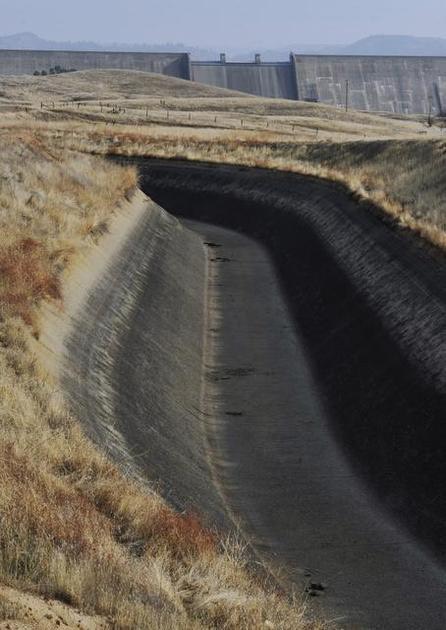No irrigation water again this year for Valley farmers
The Fresno BeeFebruary , 2015

A dry Madera Canal at Millerton Lake. — The Fresno Bee
Key developments
• 2014 farm losses are expected to be more than $2 billion — and this year could be worse, farm officials say.
• The rainfall season has been wetter, but the Sierra snowpack still is less than 20% of average heading into a fourth year of drought.
• Federal officials say they will update their forecast if stormy weather produces more water.
———
Farmers again will get no federal river water for more than 2 million acres of cropland in the San Joaquin Valley, the U.S. Bureau of Reclamation announced Friday.
Though the announcement was no surprise, it sent ripples of anxiety through the farming industry on both the east and west sides of the Valley, which rely on water from the federal Central Valley Project.
Don Peracchi, board president of the Westlands Water District’s board, mostly in west Fresno County, said: “The federal government’s Central Valley Project is broken. Some of the most vital elements of the state’s economy are being allowed to wither and die.”
The bureau, which operates the massive Central Valley Project, blamed depleted reservoirs, drought and a snowpack that is a fifth of its average size. Officials said they would update the forecast if stormy weather produces more water.
“We are bracing for a potential fourth year of severe drought, and this low initial allocation is yet another indicator of the dire situation,” said Reclamation Mid-Pacific Regional Director David Murillo.
Bureau leaders are discussing ways of supplying water for health and safety purposes to small city customers, such as Orange Cove and Huron.
This season, which unofficially ends April 1, appears to be a fourth year of drought, though this winter has been wetter than last in Northern California.
At the same time, the Sierra Nevada snowpack continues at less than a fifth of its average size for this time of year. The snowpack, which provides more than half of the state’s water in summer, is actually smaller than it was last February.
Because of rain storms this winter, there is more water in northern reservoirs, such as Shasta, than there was last year, but not enough to make a difference.
“The snowpack and runoff forecast are not as good as they were last year,” said Murillo.
Last year, hundreds of thousands of acres were left without crops, and losses are expected to be more than $2 billion. This year could be worse, farm officials said.
East Valley farmers had never experienced a zero allocation from Millerton Lake, as they did last year.
The water in Millerton was sent to a group of west Valley growers who have rights dating back to the 1800s on 240,000 acres between Patterson and Mendota. If the west-side growers could get their allotments from Shasta, the east-siders could get at least some water.
The bureau does not anticipate water would be available from Shasta. Even so, east-side farmer Harvey Bailey, who has 1,100 acres of citrus and olive trees in the Orange Cove area, is holding onto hope.
“I don’t think they know all the numbers yet,” said Bailey. “I still hope they can find enough water that we can get some.”
There was also criticism Friday about the amount of water federal officials are pumping through the Sacramento-San Joaquin River Delta. Ryan Jacobsen, executive director of the Fresno County Farm Bureau, said pumping restrictions for water quality and environmental concerns have cost the Valley water.
“This year, we’ve already lost 318,345 acre-feet of water,” he said. “And that number will only continue to rise.”
Bureau officials later said they are working daily with wildlife and other agencies to make sure delta pumping is providing as much water as possible without compromising the water quality or the ecosystem.
Last year, without river water from the federal project, farmers were forced to pump the groundwater to keep orchards and other permanent crops alive. The pumping left many rural residents with dry wells as the groundwater levels dropped, especially on the east side of the Valley.
On the west side, Mendota suffered with reduced sales and building permits as more people than usual flooded into food lines, said Mayor Robert Silva.
“We know what’s going to happen,” Silva said. “We’ve contacted food banks earlier, and we’re trying to be ready. But the buying power just isn’t there when we have no water.”